List of Contents
Oil and Gas Carbon Capture and Storage Market Size and Forecast 2025 to 2034
The global oil and gas carbon capture and storage market size was estimated at USD 4.02 billion in 2024 and is predicted to increase from USD 4.61 billion in 2025 to approximately USD 15.71 billion by 2034, expanding at a CAGR of 14.60% from 2025 to 2034. The increasing focus on lowering CO2 emissions, supportive government frameworks, rising popularity of CO2 enhanced oil recovery (EOR) techniques, and expansion of the oil & gas industry are among several factors driving the growth of the oil and gas carbon capture and storage market.
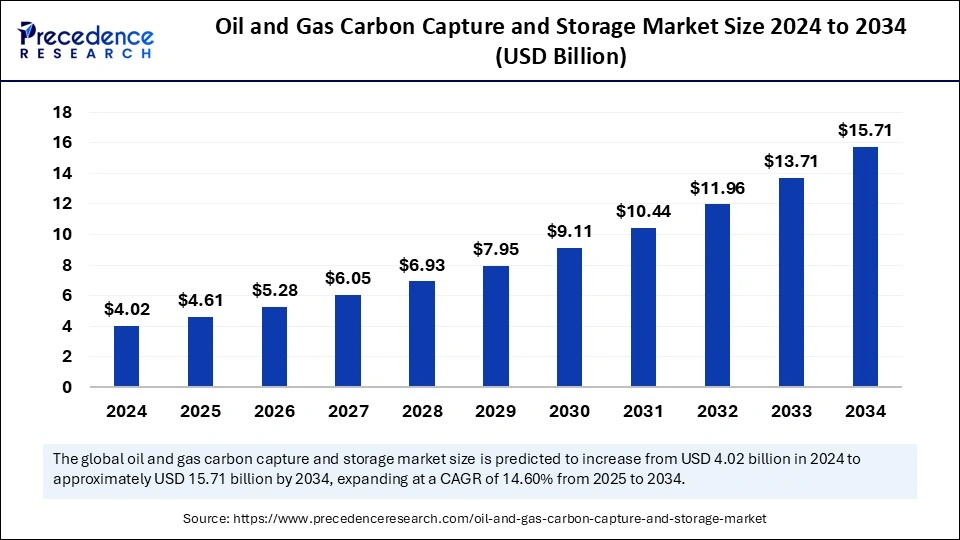
Oil and Gas Carbon Capture and Storage Market Key Takeaways
- North America dominated the global market with the largest share of 36% in 2024.
- Asia Pacific is observed to expand at a rapid pace during the forecast period.
- By technology, the post-combustion segment accounted for the major market share of 50% in 2024.
- By technology, the pre-combustion segment is expected to grow at a significant of 18.1% during the forecast period.
How does Artificial Intelligence (AI) Impact the Oil and gas carbon capture and Storage Market?
As technology continues to evolve, artificial intelligence (AI) integration presents a promising opportunity to transform the global oil and gas carbon capture and storage market. AI-driven automation processes can enhance the effectiveness of carbon capture systems and significantly improve maintenance practices in oil & gas installations. AI holds the potential to optimize carbon removal technologies and ensure more efficient as well as scalable sustainability practices. AI-powered evaluation systems can considerably enhance the oil & gas industry's efforts in carbon capture and storage (CCS) by enabling accurate real-time monitoring, providing predictive analytics, and optimizing processes. AI solutions can continuously evaluate carbon removal operations by effectively analyzing the massive amount of environmental data from satellite imaging, sensors, operational metrics, and others. Machine learning algorithms can also assist in predicting future emissions trends, optimizing carbon storage methods, and suggesting the required adjustments to boost the effectiveness of carbon removal technologies. By leveraging predictive models, AI assists the oil & gas industry in proactively addressing critical environmental risks and boosts sustainability.
U.S. Oil and Gas Carbon Capture and Storage Market Size and Growth 2025 to 2034
The U.S. oil and gas carbon capture and storage market size was exhibited at USD 1.13 billion in 2024 and is projected to be worth around USD 4.50 billion by 2034, growing at a CAGR of 14.81% from 2025 to 2034.
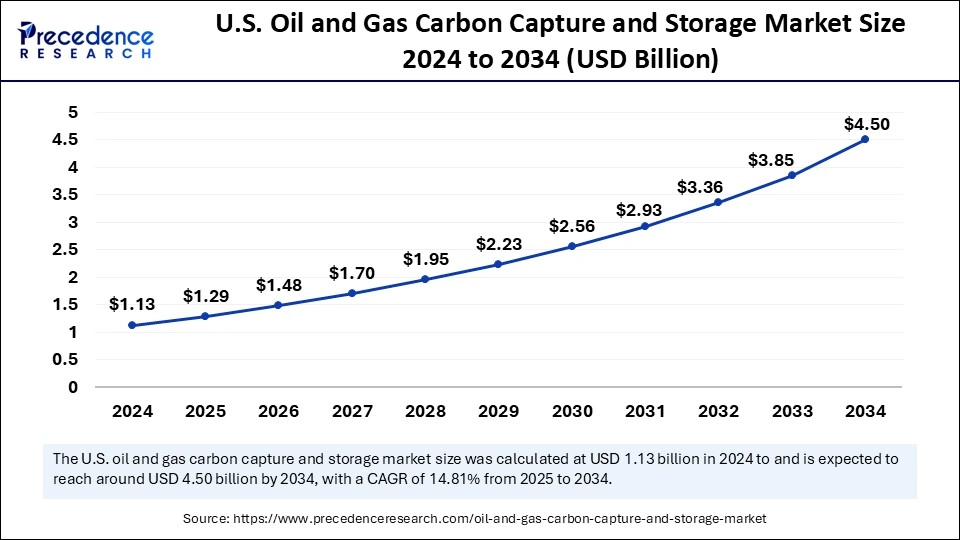
North America dominated the oil and gas carbon capture and storage market with the largest share in 2024. The region's dominance is mainly attributed to stringent emission regulations and the high acceptance of advanced carbon-capturing technologies. The region is likely to sustain its position throughout the forecast period due to the growing popularity of CO2-EOR methods. Additionally, the rising integration of carbon CCS and EOR technologies with renewable energy sources holds great potential to create a more sustainable energy ecosystem. These technologies can assist in reducing greenhouse gas emissions from fossil fuel production and increase the utilization of solar energy and wind energy sources.
- In August 2023, the U.S. Department of Energy (DOE) announced up to USD 1.2 billion to America's first two direct air capture (DAC) Hubs in Texas and Louisiana as well as 19 additional projects that aim at deploying future DAC Hub facilities. According to the DoE, together, these projects are expected to remove more than 2 million metric tons of carbon dioxide (CO2) emissions each year from the atmosphere. The two hubs are the first to be selected from the Bipartisan Infrastructure Law-funded Regional Direct Air Capture (DAC) Hubs program, which aims to kickstart a network of large-scale carbon removal sites.
- According to the article published in June 2024, Canadian and Alberta governments are lining up more than USD 15.3 billion in tax credits to the country's largest oil sands producers for building CCS projects.
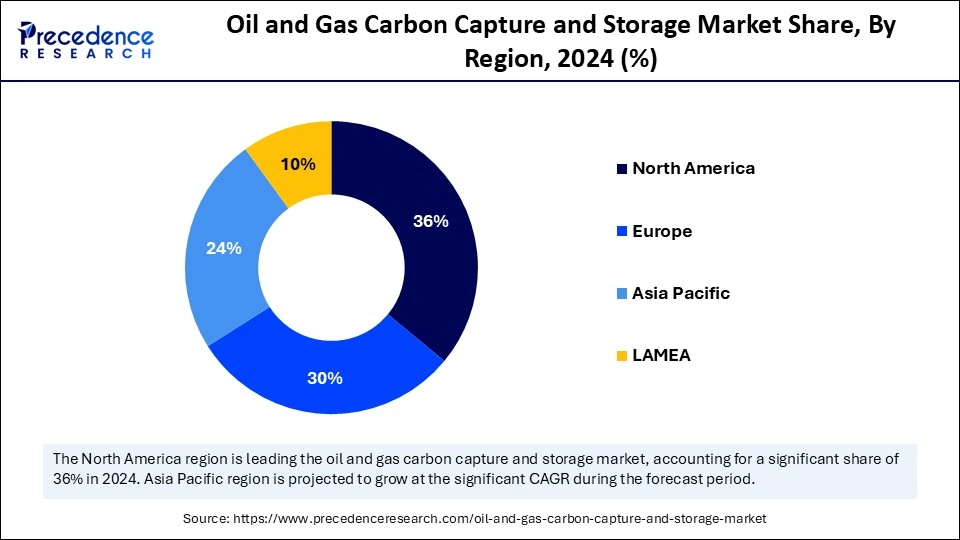
Asia Pacific is expected to witness the fastest growth during the forecast period. There is a strong focus on lowering greenhouse emissions, which contributes to the Asia Pacific oil and gas carbon capture and storage market. The rising public-private investments in the oil & gas industry, integration of CCS with renewable energy sources, and growing demand for CO2-EOR methods are expected to boost the growth of the market in the region during the forecast period. The rising government efforts to promote sustainability are boosting the demand for CCS. In addition, governments of various countries such as China, Japan, and India are making efforts to achieve carbon neutrality and boost sustainability. Such factors boost the growth of the market in the region.
The European oil and gas carbon capture and storage market is expected to grow at a notable rate in the foreseeable future. Stringent emission standards and the availability of robust carbon storage infrastructures are likely to support regional market growth. There is a strong emphasis on reducing emissions from industrial activities, boosting the adoption of CCS. European Union's commitment to net-zero emissions further contributes to market growth.
Market Overview
In recent years, the urgent need to address the climate change issue has compelled industries to invest in sustainable solutions. The oil & gas sector is one of the major contributors to carbon emissions. Carbon capture and storage (CCS) technology emerges as a promising solution to capture carbon dioxide (CO2) emissions and geologically store them safely in an underground location. CCS is proven to be a crucial technology in the oil & gas industry to reduce greenhouse gas emissions. The implementation of CCS and EOR can significantly enhance oil production while reducing emissions. Sustainability in the oil & gas industry has become a crucial focus to combat climate change. The rising focus on lowering carbon emissions in the environment has increased the demand for carbon capture and storage (CCS) in the oil & gas industry sector. Carbon capture and storage promote sustainable development and mitigate global warming.
- According to Wood Mackenzie's prediction, by 2034, the world will reach a carbon capture capacity of 440 million tonnes per annum (Mtpa) while storage capacity will reach 664 Mtpa, requiring USD 196 billion in total investment.
Oil and Gas Carbon Capture and Storage Market Growth Factors
- The growing demand for carbon dioxide in enhanced oil recovery (CO2-EOR) methods is anticipated to contribute to the overall growth of the market. CO2-EOR is widely being adopted for its potential to significantly enhance ultimate recovery from mature conventional oil reserves. It also assists in lowering greenhouse gas emissions by sequestering CO2 in subterranean geological formations.
- The rising investment from the government and private sectors in the oil & gas industry is anticipated to contribute significantly to the market's expansion.
- The rising acceptance of carbon capture and storage as one of the promising technologies to control CO2 emissions in the oil and gas industry is anticipated to significantly contribute to the overall market's expansion in the coming years.
- The supportive government initiatives on lowering CO2 emissions, along with the rapid technological innovation, are boosting the growth of the market.
Market Scope
| Report Coverage | Details |
| Market Size by 2034 | USD 15.71 Billion |
| Market Size in 2025 | USD 4.61 Billion |
| Market Size in 2024 | USD 4.02 Billion |
| Market Growth Rate from 2025 to 2034 | CAGR of 14.60% |
| Dominating Region | North America |
| Fastest Growing Region | Asia Pacific |
| Base Year | 2024 |
| Forecast Period | 2025 to 2034 |
| Segments Covered | Technology and Regions |
| Regions Covered | North America, Europe, Asia-Pacific, Latin America, and Middle East & Africa |
Market Dynamics
Driver
Increasing Environmental Concerns
The growing environmental concerns are driving the growth of the oil and gas carbon capture and storage market. Global warming is a major environmental concern around the world, resulting in the frequent occurrence of extreme weather events around the world. Carbon capture and storage (CCS) holds great potential to reduce greenhouse gas emissions from the oil and gas industry and their impact on climate change. The adoption of carbon storage methods can significantly prolong the lifetime of existing oil and gas reservoirs by enhancing recovery and lowering the level of CO2 emitted during production. This approach can provide economic benefits for oil and gas companies and minimize their operations' environmental impact. Thus, increasing efforts to lower CO2 emissions assist in achieving a low-carbon economy.
Restraint
High Initial Investment
The high initial investment associated with implementing CCS technologies in the oil & gas industry is anticipated to hinder the growth of the oil and gas carbon capture and storage market. The huge capital required for carbon capture, transportation, and storage often discourages various companies from adopting CCS solutions. In addition, the lack of availability of a well-established infrastructure can limit the feasibility of CCS projects in several undeveloped countries. Such factors are likely to restrict the expansion of the market.
Opportunity
Increasing Focus on Capturing CO2
The rising focus on capturing CO2 is projected to offer immense growth opportunities for the oil and gas carbon capture and storage market during the forecast period. Carbon capture and storage (CCS) is a crucial technology for the oil & gas industry. The energy that is generated from burning natural gas or other fossil fuels releases a large amount of CO2 into the atmosphere, which becomes a major concern as CO2 is a greenhouse gas that adversely contributes to climate change. Carbon capture and storage (CCS) allows capturing the CO2 emissions during heavy oil production, storing them safely underground in geological formations, and then releasing them into the atmosphere. The process typically involves capturing CO2 at the emission source, such as a gas plant or a boiler, and then transporting it through the pipelines to a storage site.
Technology Insights
The post-combustion segment held the dominant share of the oil and gas carbon capture and storage market in 2024. This is mainly due to the rise in the adoption of the post-combustion carbon capture and storage (CCS) technology in the oil & gas industry. Post-combustion capture is one of the most cost-effective and widely used methods. This technology removes CO2 from the exhaust gas after combustion. Post-combustion involves capturing CO2 from power plant flue gases. Stringent environmental regulations and a strong emphasis on carbon emission reduction further bolstered the segment.
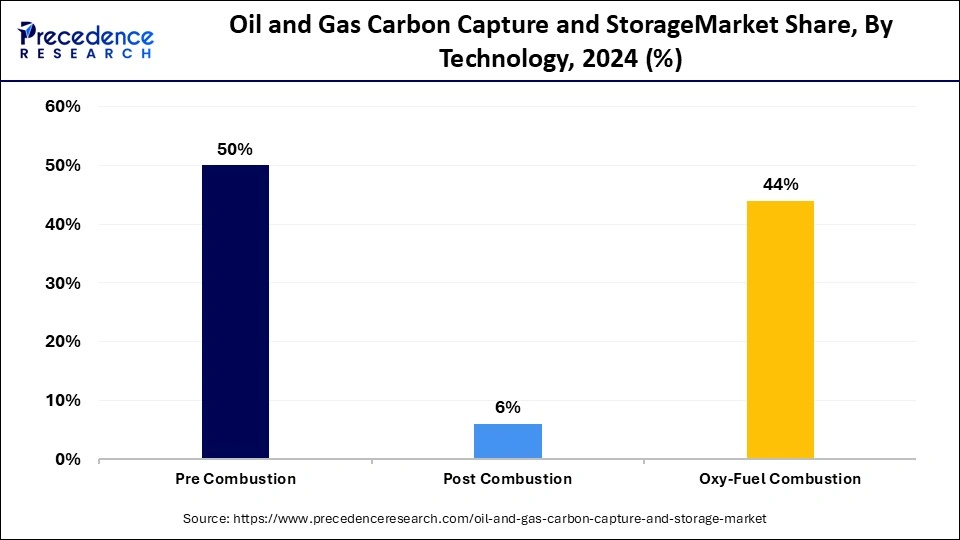
On the other hand, the pre-combustion segment is expected to grow at a significant rate during the forecast period. Pre-combustion capture involves converting fossil fuels into a gaseous mixture of hydrogen and CO2 prior to combustion. Pre-combustion capture is one of the most popular and efficient capture technologies. This technology is extensively utilized in gasification processes. It captures about 95% of the CO2 produced, which makes it very efficient and gained significant attention in the oil & gas industry.
Oil and Gas Carbon Capture and Storage Market Companies
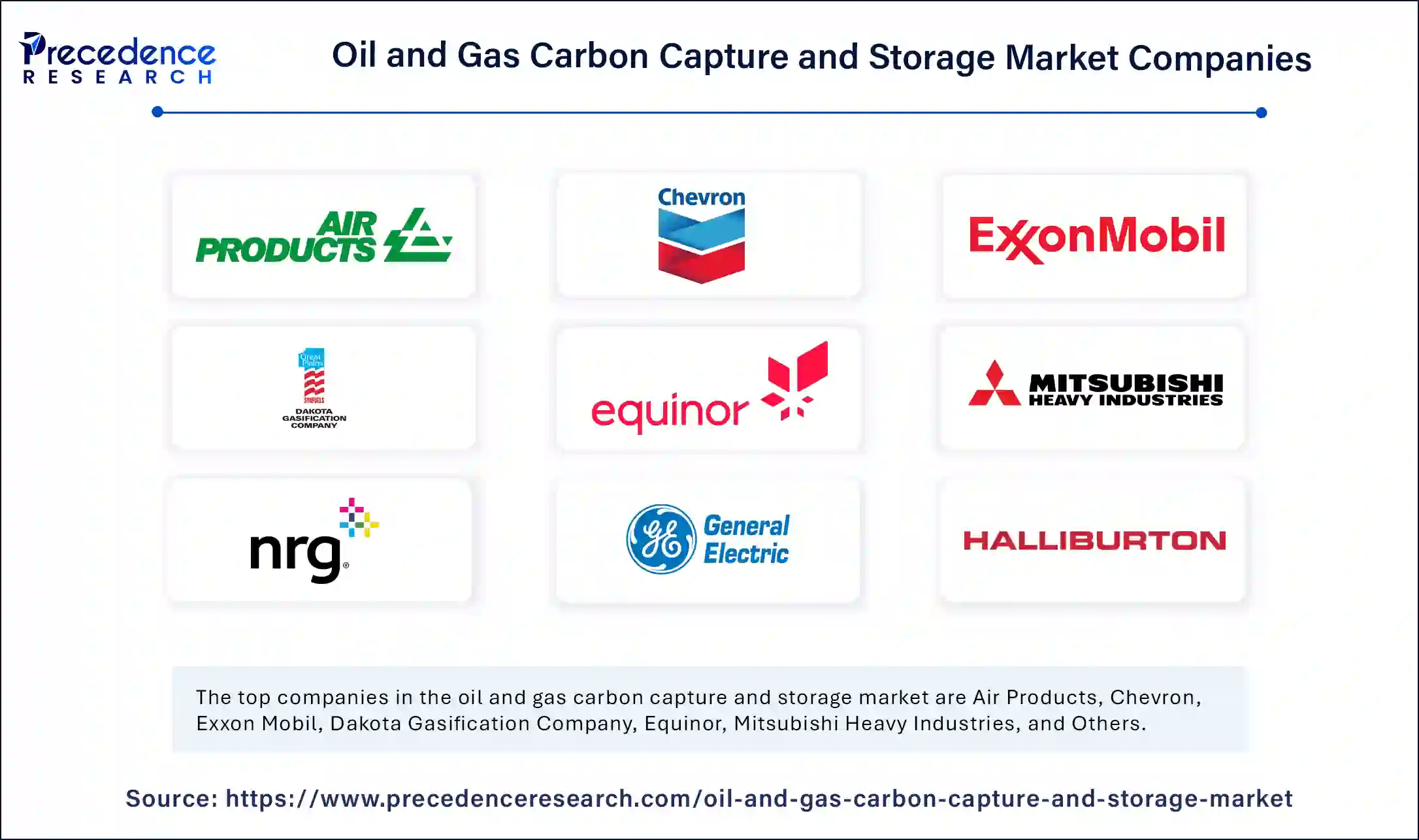
- Air Products
- Chevron
- Exxon Mobil
- Dakota Gasification Company
- Equinor
- Mitsubishi Heavy Industries
- NRG Energy
- General Electric
- Halliburton
- Linde
- Shell
- Siemens
- SLB
- Sulzer
- TotalEnergies
Recent Developments
- In December 2024, Equinor, alongside project partners, proudly announced financial close after taking a Final Investment Decision (FID) to progress to execution phase on two of the UK's first carbon capture and storage (CCS) projects in Teesside, the Northern Endurance Partnership (NEP) and Net Zero Teesside Power (NZT Power).
- In November 2024,BP and partners announced their partnership to invest USD 7 billion in a carbon capture project and gas field development in Indonesia's easternmost Papua region that could unlock 3 trillion cubic feet of additional gas resources.
- In October 2024,Rachel Reeves, the UK Chancellor, announced plans to commit almost USD 28.97 billion to fund carbon capture and storage (CCS) projects in two clusters in the north of England, which will include associated infrastructure and transportation.
Segments Covered in the Report
By Technology
- Pre Combustion
- Post Combustion
- Oxy-Fuel Combustion
By Region
- North America
- Asia Pacific
- Europe
- Latin America
- Middle East and Africa
For inquiries regarding discounts, bulk purchases, or customization requests, please contact us at sales@precedenceresearch.com
Frequently Asked Questions
Ask For Sample
No cookie-cutter, only authentic analysis – take the 1st step to become a Precedence Research client